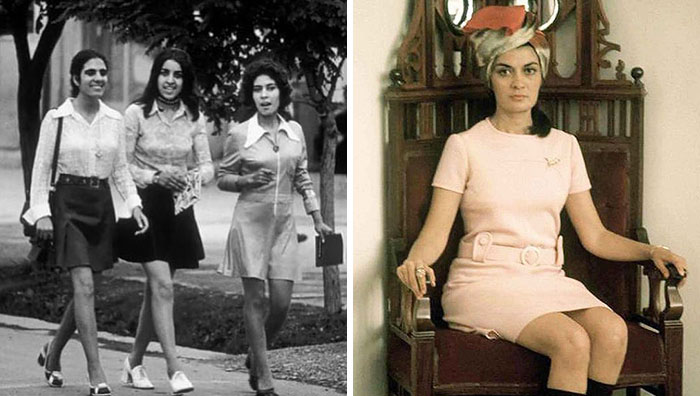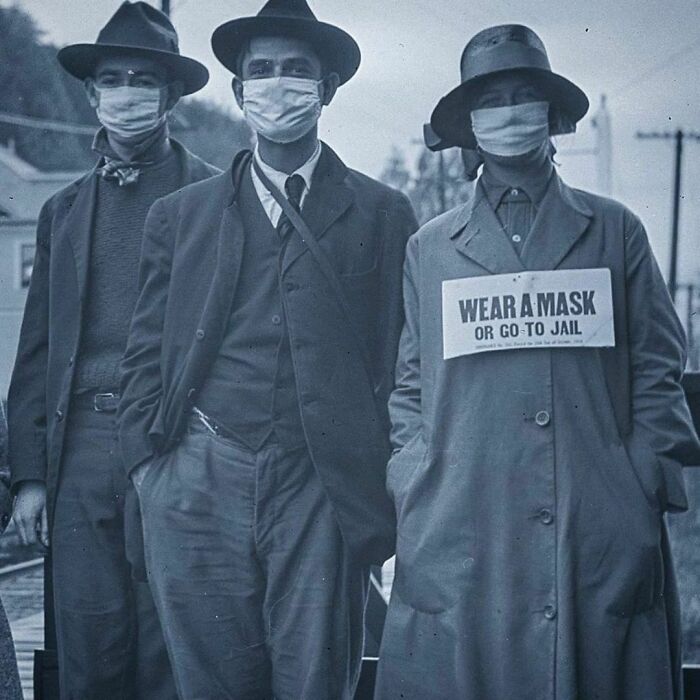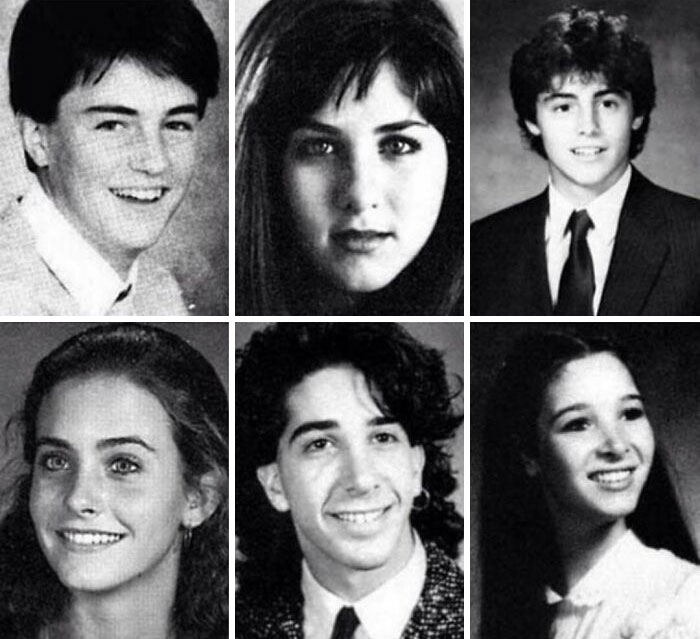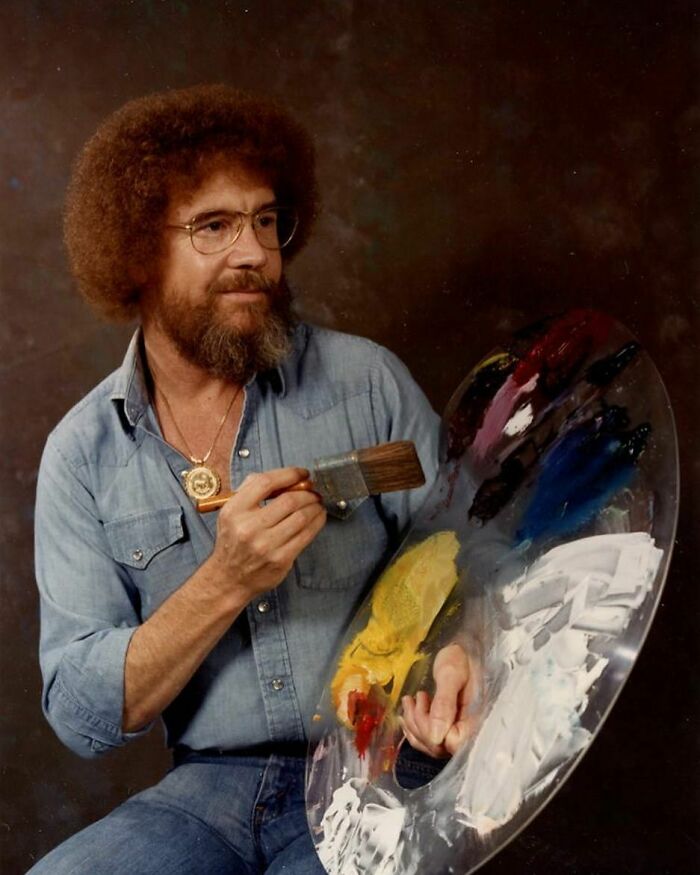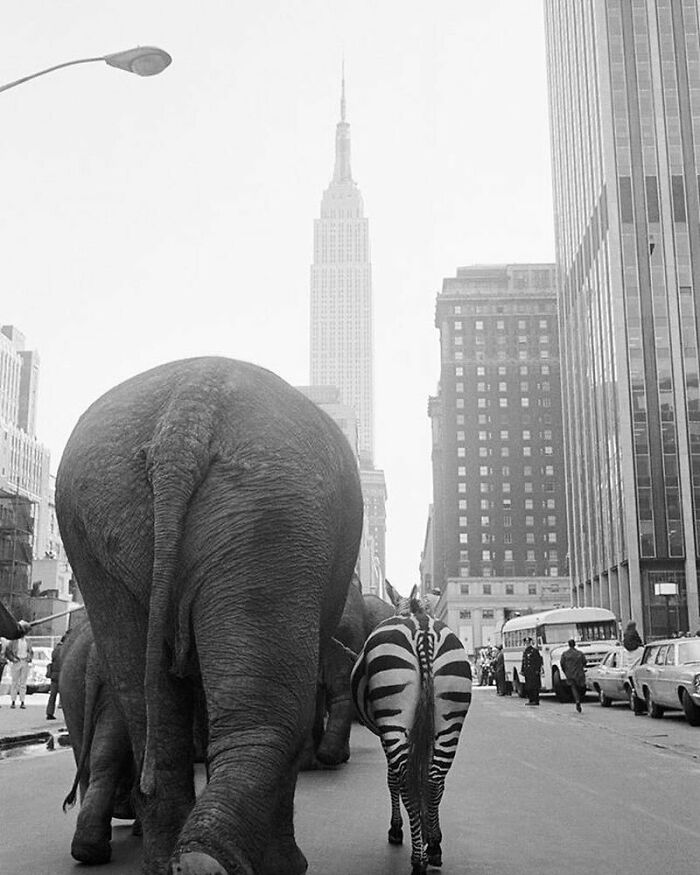
This Instagram Account Shares Fascinating Moments From History, Here Are 50 Of Our Favorites
Learning about history is always fun; truth is stranger than fiction. But a history lesson is even more exciting when there are images to coincide with fascinating stories. Allow me to introduce the “History In Pictures” Instagram account. With 4.4 million followers and over 3,600 posts, @HistoryPhotographed is famous for sharing some of the most interesting pictures that you may have never seen before.
The page’s bio states that their aim is “educating people by sharing the most powerful moments in history”, while also noting that “history should not be censored". We’ve gathered some of the most captivating vintage photographs for you to enjoy, so sit back, relax and be glad we live in a time where information about the past is unlimited.
Keep reading to also find an interview we were lucky enough to receive from Jeff Curto, photographer and host of the "History of Photography" podcast. Then if you’re looking for even more historical images later, check out this Bored Panda piece next.
This post may include affiliate links.
"When I Told My Father I Was Going To Marry Jake He Said, ‘If You Marry That Man You Will Never Set Foot In This House Again"
"He was horrified that I could contemplate marrying a black man, and I soon learned that most people felt the same way. The first years of our marriage living in Birmingham were hell — I cried every day, and barely ate. No one would speak to us, we couldn’t find anywhere to live because no one would rent to a black man, and we had no money.
People would point at us in the street. Then I gave birth to a stillborn son at eight months. It wasn’t related to the stress I was under but it broke my heart, and we never had any more children.
We were at the same technical college. I was having typing and shorthand lessons and he’d been sent there for training by the Air Force. He was with a group of black friends and they called my friend and me over to talk. We didn’t even know they spoke English, but Jake and I got chatting. He quoted Shakespeare to me, which I loved.
Jake returned to Trinidad, but we carried on writing to each other, and a few years later he returned to the UK to get better paid work.
He asked me to marry him, quite out of the blue, when I was only 19. My father threw me out, and I left with only one small suitcase to my name. No family came to our register office wedding in 1948.
But gradually life became easier. I got teaching jobs, ending up as a deputy head teacher. First Jake worked in a factory, then for the Post Office.
Slowly we made friends together, but it was so hard. I used to say to new friends: ‘Look, I have to tell you this before I invite you to my home — my husband is black.’
My father died when I was 30 and although we were reconciled by then, he never did approve of Jake.
Today we have been married for 63 years, and are still very much in love. I do not regret marrying him for an instant, despite all the pain we have suffered."
I'm so sorry zou had to get through that. You look like a lovely and very happy couple <3
We reached out to professional photographer and host of the "History of Photography" podcast Jeff Curto to get some insight from an expert in the field. When asked what he loves most about photography, Jeff told us, "What I love most about photography - its ability to interpret, alter and enhance our perception of the world in a purely visual way. It's a universal language that allows everyone to communicate on an equal basis - what you see is what I see - no translation needed." We also asked him why learning photo history is important. "If someone wants to learn photography, learning about who came before them is critical," Jeff says. "The way I always put it is this: if you wanted to start to write novels, don't you think that reading as many novels as you can, learning the history of what constitutes a novel and how they are structured would be important? Why should it be different for photography?"
Lastly, when asked how photography enhances our understanding of history, Jeff told us that "photography records history". He went on to explain that, "As soon as the camera's shutter closes, the image recorded is in the past. We can only know the past with any degree of specificity if we have a photograph of it because the camera records each and every detail. Certainly the photographer can editorialize on the scene in question by choosing what to include and what to exclude, but the moment frozen in time is still that exact moment."
Members Of The Polish Resistance During World War 2, Then To Now
While enjoying all of these great historical images, let’s take some time to learn about the history of photography itself. According to an article on The Spruce Crafts written by Liz Masoner, a professional photographer and author, the “basic concept of photography has been around since about the 5th century B.C.E”. Back then, Liz explained, “cameras” could not quite record images, but they could project them onto other surfaces. The first camera obscura, “an optical device that creates an image by focusing rays of light onto a screen or sheet of paper”, used a pinhole in a tent to project images from outside into the dark tent. While they existed before, camera obscuras were not small enough to be portable until the 17th century. Liz mentions that “basic lenses to focus the light were also introduced” around the same time.
In 1969, When Black Americans Were Prevented From Swimming Alongside Whites, Mr.rogers Invite Officer Clemmons To Join Him And Cool His Feet In A Pool, Breaking A Well-Known Color Barrier
A powerful message made from what should be just a funny image.
Photography as we know it today began in 1826 with the French inventor Joseph Nicéphore Niépce. Niépce created the first permanent photograph by using a portable camera obscura to “expose a pewter plate coated with bitumen to light”. Advancements in photography came rapidly in the following decades, with the daguerreotype, emulsion plates and dry plates being formed by the end of the 19th century.
The daguerreotype was a forerunner of modern film but was replaced by emulsion plates, or wet plates, in the 1850’s. These were less expensive and required only 2-3 seconds of exposure time, but they became obsolete quickly as well, with the invention of dry plates. The new dry gelatine plates were as high quality as wet plates but could be stored, “rather than made as needed”. These were also a huge step forward in allowing for smaller, hand-held cameras.
In 1912, Jim Thorpe, A Native American, Had His Running Shoes Stolen On The Morning Of His Olympic Track And Field Events
"He found this mismatched pair of shoes in the garbage and ran in them to win two Olympic gold medals that day.
He was also the first Native American to win a gold medal for the United States."
Photography was still an elite privilege until the 1880’s, when George Eastman started Kodak. Eastman invented a flexible roll film that no longer required photographers to constantly change the solid plates. He then went on to develop a small box camera, with one lens and no focusing adjustment, that could hold 100 film exposures. Photographers could take their own pictures then send the camera back to the factory to get their film developed and have photos printed. This was the first time cameras were accessible to the average person.
Gay Pride Parade In New York City 1974
Ris Scharoun-Deforge And Paul Deforge, A Couple With Down Syndrome Who Celebrated Their 25th Wedding Anniversary On August 13, 2018
"Kris met Paul at a dance in 1988 and she knew she had found the man she wanted to spent the rest of her life with. According to Today, Kris remembered that moment and said, “I looked into Paul’s eyes and saw my future.” After dating for five years, they decided to get married. "I proposed to him. I whispered in his ear, "Would you marry me?" And he looked up at me with this big beautiful smile and he shook his head "Yes!" And that's when I knew. He got me laughing, he was the one for me," said Kris to CBS.
Paul passed away from complications of dementia at the age of 56 less than a year after their 25th anniversary. Even during Paul's last moments, as his memory faded, his face would brighten up when he saw his wife and her overall presence would calm him."
Since then, photography has developed and adapted over time to capture cultural events and allow individuals to record their own milestones. In the 1930’s, Henri-Cartier Bresson and others began photographing “life as it occurred” rather than only staged portraits, and once World War II began, photojournalists ran with this style. A couple decades later, Polaroid released their Model 95, which blew the public’s minds by developing photos instantly. Polaroid has had a complicated history, reaching its peak in the 1960’s and 70’s, filing for bankruptcy twice between 2001 and 2009, then making a revival over the past few years, with a successful online store today.
"Everyone You Meet Always Asks If You Have A Career, Are Married Or Own A House As If Life Was Some Kind Of Grocery List. But Nobody Ever Asks If You Are Happy" - Heath Ledger
Robbin Williams As A Cheerleader For The Denver Broncos, 1979
Bernie Sanders Being Arrested In Chicago For Protesting Segregation In 1963. He Was Charged With Resisting Arrest And Fined $25
After the peak of instant images, the digital age was soon approaching. But first, SLR-type cameras became all the rage after being made widely available in the 1950’s by the Japanese brands Pentax and Nikon. These cameras made image control much easier for photographers, with new accessories like interchangeable lenses. Then, in the late 70’s and early 80’s, “compact cameras that were capable of making image control decisions on their own were introduced”. “Point and shoot” cameras allowed amateur photographers to take pictures without having to worry about controlling the shutter speed, aperture and focus. Then finally, in the 80’s and 90’s, digital cameras became widely available, leading to the advanced cameras we know and love today.
Holocaust Survivor And The Soldier Who Rescued Her In 1944
Mary Ann Bevan Entered And Won An “Ugliest Woman” Contest
Mary was born in 1874 and became a nurse in 1894. In 1903, she married Thomas Bevan and they had four children. In 1906, Mary began suffering from acromegaly, a rare condition that causes enlarged bones in feet, hands, and the face. After her husband died in 1914, Mary was unable to find work due to her appearance. To support her children she entered an “Ugliest Woman” contest; her win brought her enough attention that she was hired as a sideshow performer.
Mary provided for her family working at Coney Island Dreamland Show and Ringling Brother’s Circus. She died on December 26. 1933.
She endured ridicule and humiliation to selflessly take care of her family. She was a feminist icon and example of beauty being more than skin deep.
Women In Afghanistan During The 70s. Before Taliban
You might be wondering why photography is so important, but it has greatly impacted our lives in ways we don’t even realize. Federico Alegria, photographer and professor, explored this topic in his piece “How Photography Changed The World”. One point Alegria mentions is how “photography changes history” and “alters our perspective of the past”. Being able to broadcast events worldwide instantly allows our world to be more in sync, but having images of historical events also deepens our understanding of them. Having photos of our own lives is a great blessing as well, allowing us to better remember events and loved ones and enjoy the nostalgia of looking back whenever we want.
A Goodbye Between North- And South Korean Relatives After A Family Reunion, Who Were Separated For Over 57 Years
Patrick Swayze Once Said: “I’ve Now Ceased To Worry About Image, Because I Don't Care What People Think Of Me Anymore. Because I've Had Such A Battle With What I Think Of Me And With Trying To Find A Way To Like Myself”
This world is made for more than one biased opinion. Good for him, realizing that and living his own life. Lots of us don’t learn.
That Time When Princess Diana Broke The Royal Rules For Her Son William By Taking Part In The Sports Day Running Race At Her Son’s School
Photography has also affected how we experience social events. Wedding photos are one of the most exciting aspects of many people’s big days, and holding onto family photos is an excellent way for us to connect with our heritage. We photograph the most exciting days of our lives, our children as they grow and our travels that we want to remember for years to come. Nowadays, we can share all of these images on social media for friends and family to see as well. While Instagram has probably given some too much confidence in their photography skills, it has made sharing images with loved ones extremely accessible (not to mention that many of us find it fun too!).
The Man Behind The Iconic Photo
"Never thought about it before, but you know that famous picture of a bunch of construction workers sitting on a girder way up in the sky and having lunch? Well here's the photographer who took that picture: Charles C. Ebbets"
3 People Pose For A Photo Whilst Wearing Face Masks During The Second Wave Of The Spanish Flu In California; 1918
27-Year-Old Soviet Doctor, Leonid Rogozov, Performing Surgery On Himself To Remove An Infected Appendix During A 1961 Expedition To The Antarctic, Where He Was The Only Doctor On The Team
When it comes to pictures helping tell stories, photojournalism has become crucial to news sources in the past century. Modern photojournalism developed in Germany in 1925, followed by another German innovation: the photo magazine. But once Hitler began to gain power in Germany, many of these magazines were suppressed, and most of the editors ended up fleeing the country. By 1936, however, American magazine magnate Henry Luce launched Life Magazine in the US. Life became incredibly influential, especially during World War II, and photojournalism became an important way of documenting global events.
Job Hunting In 1930's
A Beach In Iran A Few Months Before The Islamic Revolution. 1978/79
It’s about power and control. Religion is not to blame. It is those who interpret it in a way that benefits themselves, which is not what God (in any religion) wants.
Yes! Power and control. Religion just happens to be an excellent tool to use.
Load More Replies...Revolution? Suppression of women pure and simple by the male of the species
Sad thing is women played a big part in the revolution, they wanted change but it wasn't until it was too late that they realised just what kind of leaders they had helped bring into place and the extent of the changes they would make
Load More Replies...Is there an example in history where „more religion“ made a society better than it was before?
They have all the money and connections and power of the police and the govt
Load More Replies...Stop simply blaming Islam. The girls in this photo were almost certainly already Muslim. It's just a restrictive interpretation of certain laws that changed the way they had to dress. In Tunisia, a Muslim country, women are allowed to choose how they dress. And I am not a Muslim, so this is not from a biased point of view,
The things that take place because a select few got so upset over something so small and decided to ruin it for everyone. Sounds familiar actually.
Sadley it’s the crazies who made Islam what we think of it today. I am sure these women were Islamic
This kills me 💔 So many women today who have never known the freedom to live like this...
A former boyfriend of mine was born in Teheran around that time. His parents and himself are so messed up from what happened. They fled the country when he was very young, but the stories are very much alive. And the panick too. His mother could not go 3 or 4 hours without calling him. Not because she was a controlling Karen, but because she was so traumatised and so afraid of what might or might not happen. It's heartbreaking. (we broke up because we just had a fling for half a year, had nothing to do with anything else)
Why should any women have ti be ashamed of who they are just bc they happened to be born wo a penis? Why should any woman be responsible for how a many sees them as merely objects to stick their penis in? They aren't viewed as people they're viewed as something dirty that must be hidden so men don't hurt them like it's an insult to see womens hair or their frigging shoulders. They are not property they have their own minds and feelings and pain and to be viewed as needing protection like an infant is degrading and dehumanizing. To be controlled is horrible and then to be brainwashed to accept it is even worse. Women are not robots. All bc they don't have a penis they are less than male children how horrid. And how unbelievably incredulous A penis is 3 inches of skin that's what determines a person's superiority? Ugh Evangelicals are no better it's all a dangerous cult all organized religion
Load More Replies...Daily mail will welcome you im sure you'll love it on their comment page
Load More Replies...Religion and patriarchy are scourges on the planet and need to be eradicated. FIFY.
Load More Replies...Rms Queen Elizabeth Returning 15,000 Soldiers To New York At The End Of Ww2 1945. The Ship Was Not Overcrowded, Soldiers Simply Ran To The Deck As They Arrived
Some regard the golden age of photojournalism as 1935-1975. For the first time in history, startling images of war and other historical events were widely available with captivating stories alongside them. Famous images from the years between the Great Depression and World War II live on in many people’s minds. One of the most iconic examples is “Migrant Mother from Nipomo”, a photograph taken by Dorothea Lange in California in 1936. The photo, featuring a mother with two of her children turning away from the camera, was taken during a project “commissioned by the Farm Security Administration in the pursuit of capturing the impact of the Great Depression on the American families”.
“An Empty Stomach, An Empty Wallet And A Broken Heart Can Teach You The Best Lessons Of Life” - Robin Williams
Economy Class On Pan Am 747 In The Late 60's
The Models Of The "American Gothic" Painting
Another iconic image that came after the end of World War II is “V-J Day In Times Square” taken by Alfred Eisenstaedt in 1945. The photo features a nurse and a sailor enjoying a passionate embrace in celebration of the war being over. It’s safe to assume that both individuals witnessed horrific sights during the war, but thanks to photojournalism, one moment of pure joy was able to be captured as well.
A Skateboarder Zipping Through Central Park In The 1960s
Guardsman Fainted During A Ceremony, But Other Guards Kept Their Attention. London, 1966
I still consider such things a bit absurd. The military etiquette before a possible dangerous situation
George Lucas Surrounded By Star Wars Props
Learning about history through images is an amazing way to better understand our world. We’re so fortunate to live in a time where we can hop on Instagram and find out about the amazing people and stories featured in this list. Be sure to upvote your favorite photos and stories and let us know in the comments if you learned anything from this list!
Lady Norman On Her Scooter/Autoped, 1916
Father Faints When He Meets His Triplet Babies For The First Time In 1946. This Was Before Ultrasound Was Invented
The fella holding him doesn't seem to be using much strength to keep him up or showing even the tiniest degree of concern (which most people would if someone passes out - it startles if nothing else). I'm wondering if he jokingly pretended to faint. Might be miles off of course! 🤷
Temple Of Kukulcán (El Castillo)
A Woman Celebrating Birthday In Tehran, Iran In 1973
A Man Browsing For Books In Cincinnati's Cavernous Old Main Library. The Library Was Demolished In 1955
Discovering The Mona Lisa, After Ww2
A Knocker-Upper Was Someone Whose Purpose Was To Wake People Up During A Time When Alarm Clocks Were Expensive And Not Very Reliable. They Earned About Six Pence A Week Using A Pea Shooter To Shoot Dried Peas At The Windows Of Sleeping Workers In East London, 1930s. She Would Not Leave A Window Until She Was Sure That The Workers Had Woken Up
More Than 40 Years Later!
Jerry Stiller- Takes His Son Ben Stiller To A Play (1978)
Good Lord. Jerry looks the same in 1978 as he did in 1998 twenty years later when Seinfeld ended. Wow!
Behind-The-Scenes Photos From Titanic, 1997
“We were kind of the two goofy kids on the set,” Kate Winslet told Rolling Stone in 1998. “Y’know, working with Leonardo DiCaprio — he’s a bit gorgeous, and I was worried that I was going to be bowled over by him, or that he was going to find me all stuffy and Shakespearean and English. But the second we met, we just completely clicked.”
Leonardo DiCaprio said, “She was my best friend for seven months. We’d unload the stresses of the shoot to each other, vent to each other, watch out for each other....We were partners.”
A Llama In Times Square, 1957
Goodbye Kiss At Penn Station, NY, Between A Soldier And His Loved One, And No Assurance He Ever Comes Back. 1944
The question should have an answer of whether or not he did survive the war.
Downtown Los Angeles Photographed In 1901, And Again In 2001, Exactly 100 Years Later
New York In The Early 1900s. Colorized By Sanna Dullaway
For anyone who cares: the NY stock exchange was opened, Flatiron was built, and Williamsburg bridge opened. Population was 3.4 million!
Ladies Going Shopping In Colorful Shorts, Los Angeles, 1960. Photograph By Allan Grant. Colorized By Kostas Fiev
California Street, San Francisco. 1964
Rome, Italy In The 60s Was A Vibe
Beautiful Photo Of The Twin Towers In 1979
Old Photos Of The Cast Of "Friends"
Tobey Maguire And Leonardo Dicaprio Bowling, 1989
The Simpsons" Writing Room, 1992
A Man Begs For His Wife’s Forgiveness Inside A Divorce Court, Chicago, 1948
In 1979, 16 Year Old Brenda Ann Spencer Was Arrested After Killing Two People In California. When Asked Why She Did It, Her Reply Was "I Just Don't Like Mondays"
Some of these do not belong on this list. They are not powerful moments in history. Leo Dicaprio going bowling or Elizabeth Taylor dressed as Cleopatra or hell even Heath Ledger do not belong on this list and neither should be they be ranked higher than holocaust survivors, people suffering through segregation, separation and warped political ideologies.
So, I know some folks are not going to like the fact that celebrities are represented in this list. For those movie buffs out there these pictures are historical and you know what? That is ok! Let folks enjoy what they enjoy. :) Also, please note that the ranking system is selected by us the viewer. Some will be angry that celebrities are rated higher but keep in mind, Bored Panda didn't make the ranking. They just provide the avenue for us to vote. We decided who would be the highest. And look at the top vote! An amazing love story!
Some are historical for movie buffs, yes, though I still fail to see how Leo bowling is one of the most powerful moments in history. The title was originally most powerful moments in history so I’m sure you can see why some people, myself included, have taken issue (I see they’ve changed it from ‘powerful’ to ‘fascinating’ now though, but, again, I’m still not sure how Leo bowling qualifies 🤷♀️). Also, yes, the placing on the list is down to the audience and not BP but some of these shouldn’t even be on the list in the first place for people to vote on. How about some quality control from BP once in a while. 🤷♀️
Load More Replies...Some of these do not belong on this list. They are not powerful moments in history. Leo Dicaprio going bowling or Elizabeth Taylor dressed as Cleopatra or hell even Heath Ledger do not belong on this list and neither should be they be ranked higher than holocaust survivors, people suffering through segregation, separation and warped political ideologies.
So, I know some folks are not going to like the fact that celebrities are represented in this list. For those movie buffs out there these pictures are historical and you know what? That is ok! Let folks enjoy what they enjoy. :) Also, please note that the ranking system is selected by us the viewer. Some will be angry that celebrities are rated higher but keep in mind, Bored Panda didn't make the ranking. They just provide the avenue for us to vote. We decided who would be the highest. And look at the top vote! An amazing love story!
Some are historical for movie buffs, yes, though I still fail to see how Leo bowling is one of the most powerful moments in history. The title was originally most powerful moments in history so I’m sure you can see why some people, myself included, have taken issue (I see they’ve changed it from ‘powerful’ to ‘fascinating’ now though, but, again, I’m still not sure how Leo bowling qualifies 🤷♀️). Also, yes, the placing on the list is down to the audience and not BP but some of these shouldn’t even be on the list in the first place for people to vote on. How about some quality control from BP once in a while. 🤷♀️
Load More Replies...
 Dark Mode
Dark Mode 

 No fees, cancel anytime
No fees, cancel anytime 























